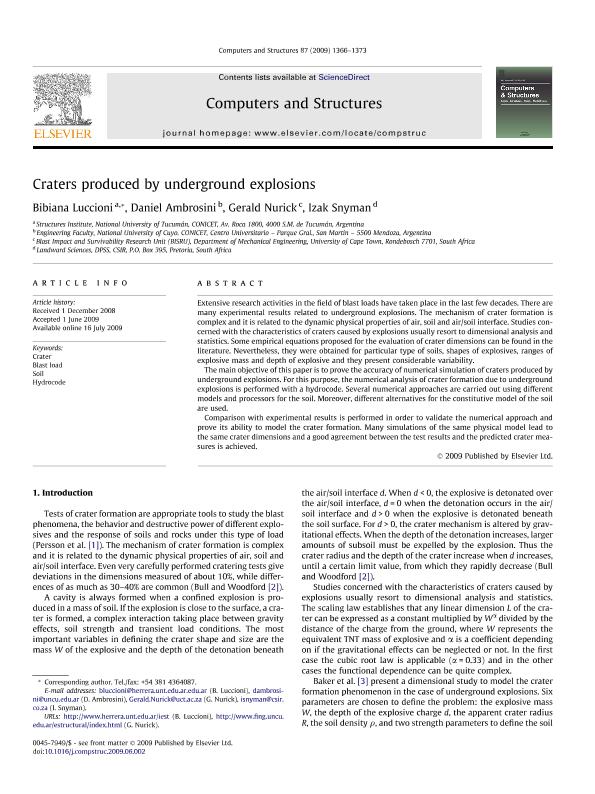Mostrar el registro sencillo del ítem
dc.contributor.author
Luccioni, Bibiana Maria

dc.contributor.author
Ambrosini, Ricardo Daniel

dc.contributor.author
Nurick, Gerald
dc.contributor.author
Snyman, Izak
dc.date.available
2019-06-13T14:22:51Z
dc.date.issued
2009-11
dc.identifier.citation
Luccioni, Bibiana Maria; Ambrosini, Ricardo Daniel; Nurick, Gerald; Snyman, Izak; Craters produced by underground explosions; Pergamon-Elsevier Science Ltd; Computers & Structures; 87; 21-22; 11-2009; 1366-1377
dc.identifier.issn
0045-7949
dc.identifier.uri
http://hdl.handle.net/11336/78176
dc.description.abstract
Extensive research activities in the field of blast loads have taken place in the last few decades. There are many experimental results related to underground explosions. The mechanism of crater formation is complex and it is related to the dynamic physical properties of air, soil and air/soil interface. Studies concerned with the characteristics of craters caused by explosions usually resort to dimensional analysis and statistics. Some empirical equations proposed for the evaluation of crater dimensions can be found in the literature. Nevertheless, they were obtained for particular type of soils, shapes of explosives, ranges of explosive mass and depth of explosive and they present considerable variability. The main objective of this paper is to prove the accuracy of numerical simulation of craters produced by underground explosions. For this purpose, the numerical analysis of crater formation due to underground explosions is performed with a hydrocode. Several numerical approaches are carried out using different models and processors for the soil. Moreover, different alternatives for the constitutive model of the soil are used. Comparison with experimental results is performed in order to validate the numerical approach and prove its ability to model the crater formation. Many simulations of the same physical model lead to the same crater dimensions and a good agreement between the test results and the predicted crater measures is achieved.
dc.format
application/pdf
dc.language.iso
eng
dc.publisher
Pergamon-Elsevier Science Ltd

dc.rights
info:eu-repo/semantics/openAccess
dc.rights.uri
https://creativecommons.org/licenses/by-nc-sa/2.5/ar/
dc.subject
Crater
dc.subject
Soil
dc.subject
Blast Load
dc.subject
Hydrocode
dc.title
Craters produced by underground explosions
dc.type
info:eu-repo/semantics/article
dc.type
info:ar-repo/semantics/artículo
dc.type
info:eu-repo/semantics/publishedVersion
dc.date.updated
2019-06-10T20:20:45Z
dc.journal.volume
87
dc.journal.number
21-22
dc.journal.pagination
1366-1377
dc.journal.pais
Reino Unido

dc.journal.ciudad
Londres
dc.description.fil
Fil: Luccioni, Bibiana Maria. Consejo Nacional de Investigaciones Científicas y Técnicas. Centro Científico Tecnológico Conicet - Tucumán; Argentina
dc.description.fil
Fil: Ambrosini, Ricardo Daniel. Universidad Nacional de Cuyo; Argentina. Consejo Nacional de Investigaciones Científicas y Técnicas; Argentina
dc.description.fil
Fil: Nurick, Gerald. University of Cape Town; Sudáfrica
dc.description.fil
Fil: Snyman, Izak. Landward Sciences; Sudáfrica
dc.journal.title
Computers & Structures

dc.relation.alternativeid
info:eu-repo/semantics/altIdentifier/doi/https://dx.doi.org/10.1016/j.compstruc.2009.06.002
Archivos asociados
